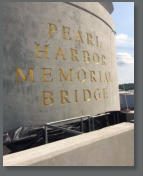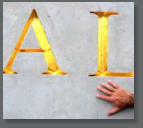
Case Study: Q-Bridge
A few years back we did a set of True Prismatic mold letters for a
bridge in Connecticut. But in this case the letters were being attached
to the inside of a curved steel form (you can see the curve of the piling
in photos 1 and 2). The HDU was too brittle to be used here. It would
have broken when they tried to force it to the curve of the form. Plus,
the mold letters had to hold up for two pours.
So what we had to do was to hand-carve the reversed letters out of 2"-
thick HDU and then fill and prime the HDU to give it a smooth, non-
porous surface (In the first photo below we are sanding the carved and
primed letter). We then made silicone molds of these HDU letters
(Photo showinf the orange silicone mold within a blue foam retainer).
Then we cast a tough but slightly flexible copy of the HDU letter we
had carved (Photo of amber-colored reversed "P"). This gave the
customer a mold letter that was True Prismatic, flexible enough to
conform to the curve of the steel form and tough enough to withstand
multiple pours.

True Prismatic
Now the V-Bottomed molds we've been talking about are the
Simulated Prismatic style. This is a very affordable way to go. But
sometimes only the Real Deal will do - True Prismatic Letters! To do
this we actually hand-carve the letters in HDU foam. These are truly
works of art. But, because they are made of HDU foam, they are not as
durable as the Duro-Tek letters, nor do they have the smooth, non-
porous edge that Duro-Tek has. That means that the letters have to be
filled and painted, and even then a mold release agent will be
necessary.
Also, due to all the hand-labor, these mold letters are more expensive
then the V-Bottom and Flat-Bottom products. That said, though, True
Prismatic letters are really special.
So, since the Flat-Bottom letter molds are easier to make and can be
made with thinner sheets of Duro-Tek, they are often the least
expensive way to go.









Case Study: Q-
Bridge
A few years back we did a set of True
Prismatic mold letters for a bridge in
Connecticut. But in this case the
letters were being attached to the
inside of a curved steel form (you
can see the curve of the piling in
photos 1 and 2). The HDU was too
brittle to be used here. It would have broken when
they tried to force it to the curve of the form. Plus,
the mold letters had to hold up for two pours.
So what we had to do was to hand-carve the
reversed letters out of 2"-thick HDU and then fill and
prime the HDU to give it a smooth, non-porous
surface (In the first photo below we are sanding the
carved and primed letter). We then made silicone
molds of these HDU letters (Photo showinf the
orange silicone mold within a blue foam retainer).
Then we cast a tough but slightly flexible copy of the
HDU letter we had carved (Photo of amber-colored
reversed "P"). This gave the customer a mold letter
that was True Prismatic, flexible enough to conform
to the curve of the steel form and tough enough to
withstand multiple pours.

True Prismatic
Now the V-Bottomed molds we've been
talking about are the Simulated
Prismatic style. This is a very affordable
way to go. But sometimes only the Real
Deal will do - True Prismatic Letters! To
do this we actually hand-carve the letters
in HDU foam. These are truly works of
art. But, because they are made of HDU
foam, they are not as durable as the
Duro-Tek letters, nor do they have the
smooth, non-porous edge that Duro-Tek
has. That means that the letters have to
be filled and painted, and even then a mold release agent
will be necessary.
Also, due to all the hand-labor, these mold letters are
more expensive then the V-Bottom and Flat-
Bottom products. That said, though, True Prismatic
letters are really special.
So, since the Flat-Bottom letter molds are easier to make
and can be made with thinner sheets of Duro-Tek, they
are often the least expensive way to go.



















































